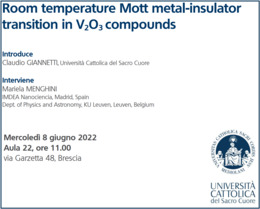- Brescia
- Dipartimento di Matematica e Fisica
- Eventi
- Room temperature Mott metal-insulator transition in V2O3 compounds
Room temperature Mott metal-insulator transition in V2O3 compounds

Aula 22, ore 11.00.
via Garzetta 48, Brescia
Mariela MENGHINI
IMDEA Nanociencia, Madrid, Spain
Dept. of Physics and Astronomy, KU Leuven, Leuven, Belgium
Abstract
One of the consequences of strong electron-electron interactions in transition metal oxides is the transition from the Mott insulating phase to a metal, and therefore several orders of magnitude change in resistance, as external parameters are varied. The metal-insulator transition (MIT) in these materials has been a longstanding topic of research both from a theoretical and experimental point of view. Vanadium sesquioxide (V2O3) is an archetypal Mott insulator in which a purely electronic isostructural Mott transition in bulk Cr-doped V2O3 between corundum paramagnetic metallic (PM) and insulating (PI) phases near room temperature. Remarkably, this phase transition has been elusive in thin film compounds so far. In this talk, I will present our results demonstrating a room temperature Mott metal-insulator transition (MIT) in 1.5% Cr-doped and pure V2O3 thin films achieved via continuous lattice deformations induced by heteroepitaxy. This MIT is characterized by a colossal change (ΔR/R up to 100,000 %) in room temperature resistivity and a broad range of optical constants values as a consequence of a strain-modulated bandgap. Moreover, the controlled epitaxial strain allows to stabilize the structural, electronic, and optical properties of the films at different intermediate states, between the PM and PI phases, inaccessible in bulk materials. Controlling phase transitions in correlated systems by epitaxial strain can offer a radical new approach to create the next generation of Mott devices.
